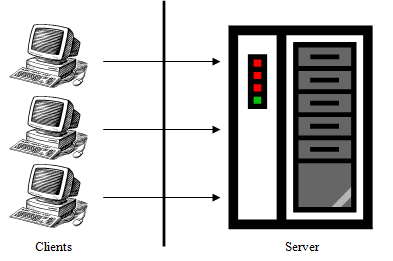| Client tier architecture | |
Client server architecture is very common across a network and must be supported by the NOS. The server is essentially one or more machines which provide a specific service. Their peers are other servers doing the same task rather than all computers connected to the network. Some example servers could be web servers, file servers or application servers. Each of these provide a service to other computers.
Clients are the computers who access the servers in order to use a service. For example each computer on the school network accesses files from a file server. Below is a diagram showing client server architecture.
Each client sends a request to the server in order to provide a function. If the server is a file server, then the client may request a specific file. The server will then respond by sending that file over the network. As the server provides a specific service, the clients always know where to look in order to do an activity. Some example uses are
manages and reports on the use of the system's resources, such as each user's hard disk allocation and how many prints they are allowed to do. provides a number of different user interfaces. This allows different categories of user to access the network, for example, an interface to allow the network administrator to set up account, an interface to allow the personnel manager to access employee details or an interface to allow secretaries to access generic applications. This architecture requires a NOS to manage all of the resources. The NOS will manage all of the above functions of a server and ensure that client request are dealt with. |
|

| Links |
| Network OS |
| Peer to peer |
 Custom Search
Custom Search
